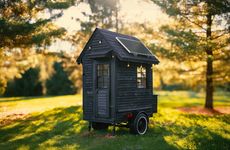The upside down house called "The World Stands on its Head" was built as a tourist attraction in Trassenheide, a German town on the Baltic Sea island of Usedom.
The Polish born German business man who had it built wanted it to be an "experiment for the senses." The Cape Cod-style house had to be built with a steel frame because of the tremendous weignt on the section of the roof poking into the ground. The 120 meter square home has to be accessed through the attic. About the only thing the right side up is the stairs because the visitors need to go up them to get to the "ground" floor.
Upside-Down Architecture
'The World Stands on its Head' House
Trend Themes
1. Upside-down Structures - The trend of creating upside-down structures as tourist attractions presents an opportunity for architects and builders to experiment with new design techniques and materials.
2. Sensory Experiences - The demand for unique and immersive sensory experiences, such as visiting an upside-down house, can be a disruptive innovation opportunity for the hospitality and tourism industries.
3. Innovative Building Methods - Building structures with unconventional materials or designs, such as using a steel frame to support an upside-down house, presents potential disruptive innovation opportunities for the construction industry.
Industry Implications
1. Architecture - The trend of upside-down structures can create opportunities for architects to develop new design strategies and techniques.
2. Tourism - Upside-down structures offer a unique attraction for tourists and can potentially disrupt the tourism industry with innovative and immersive sensory experiences.
3. Construction - Innovative building methods, such as supporting an upside-down house with a steel frame, can present disruptive opportunities for the construction industry to explore new materials and techniques.






